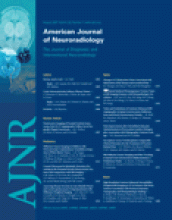Abstract
BACKGROUND AND PURPOSE: The purpose of this work was to demonstrate susceptibility effects (SusE) in various types of brain tumors with 3T high-resolution (HR)-contrast-enhanced (CE)-susceptibility-weighted (SW)-MR imaging and to correlate SusE with positron-emission tomography (PET) and histopathology.
MATERIALS AND METHODS: Eighteen patients with brain tumors, scheduled for biopsy or tumor extirpation, underwent high-field (3T) MR imaging. In all of the patients, an axial T1-spin-echo (SE) sequence and an HR-SW imaging sequence before and after IV application of a standard dose of contrast agent (MultiHance) was obtained. Seven patients preoperatively underwent PET. The frequency and formation of intralesional SusE in all of the images were evaluated and correlated with tumor grade as determined by PET and histopathology. Direct correlation of SusE and histopathologic specimens was performed in 6 patients. Contrast enhancement of the lesions was assessed in both sequences.
RESULTS: High-grade lesions demonstrated either high or medium frequency of SusE in 90% of the patients. Low-grade lesions demonstrated low frequency of SusE or no SusE. Correlation between intralesional frequency of SusE and histopathologic, as well as PET, tumor grading was statistically significant. Contrast enhancement was equally visible in both SW and SE sequences. Side-to-side comparison of tumor areas with high frequency of SusE and histopathology revealed that intralesional SusE reflected conglomerates of increased tumor microvascularity.
CONCLUSIONS: 3T HR-CE-SW-MR imaging shows both intratumoral SusE not visible with standard MR imaging and contrast enhancement visible with standard MR imaging. Because frequency of intratumoral SusE correlates with tumor grade as determined by PET and histopathology, this novel technique is a promising tool for noninvasive differentiation of low-grade from high-grade brain tumors and for determination of an optimal area of biopsy for accurate tumor grading.
- Copyright © American Society of Neuroradiology












